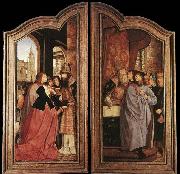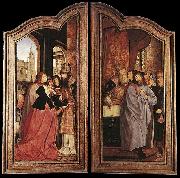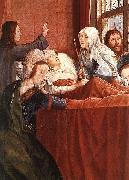
Oil On
Canvas, Real Flavor of Old Masters
|
MASSYS, Quentin
|
|||
|
|
|||
| Flemish Northern Renaissance Painter, ca.1465-1530 Quentin Massys, also spelled Matsys or Metsys, was born in Louvain, the son of a blacksmith. He is traditionally thought to have been trained in that craft by his father. Art in Louvain while Massys was growing up was dominated by Dirk Bouts. Massys became a member of the painters' guild in Antwerp in 1491 and died there in 1530. He represented a current of painting that flourished in Antwerp at this time of its sudden new prosperity. Erwin Panofsky (1953) described this trend, "archaism of around 1500," as "a prelude to, in fact a fact of, the Renaissance in Netherlandish painting," which prevailed in the southern Netherlands. The monumental Enthroned Madonna (Brussels), an early work by Massys, has features recalling both Robert Campin and Jan van Eyck. The central panel of Massys' imposing St. Anne Altarpiece, or the Holy Kinship (Brussels), which was commissioned for the church of St-Pierre in Louvain in 1507 and signed and dated 1509, has a prototype in the Holy Kinship of Geertgen tot Sint Jans. Even the physical types and costumes in Massys' version refer to Geertgen's. But Massys placed his rhythmically balanced figure groups in a domed, arcaded loggia that in architectural style appears to be reaching for a Renaissance vocabulary it cannot quite attain; certainly the architecture evokes a later period than that represented by the Gothic throne of the Enthroned Madonna. The calm and restraint of the St. Anne Altarpiece are replaced by heightened emotional expression in the next important painting by Massys that can be firmly dated, the Deposition triptych (Antwerp). This was commissioned in 1508 by the guild of joiners in Antwerp for their chapel in the Cathedral; Massys completed the composition in 1511. It was inspired by Rogier van der Weyden's great Deposition, which was in the church of St-Pierre in Louvain in Massys' time, and also quotes from Rogier's Entombment. Massys painted genre subjects, possibly with emblematic meaning, such as A Money Changer and His Wife, which belonged to a Netherlandish tradition that maintained its popularity right through the 17th century. In portraiture he made significant contributions. His pair of portraits of Erasmus and Petrus Aegidius, painted in 1517 for Sir Thomas More, set the pattern for representations of the scholar in his study. | |||
|
|
|||
|
|
St Anne Altarpiece new21/MASSYS, Quentin-746687.jpg Painting ID:: 64220 Visit European Gallery |
1507-08 Oil on wood, 220 x 92 cm (each wing) Musees Royaux des Beaux-Arts, Brussels The backs of the wings, when the triptych is closed, juxtapose two scenes. The first takes place beneath the portico of a church, the double arch of which gives onto a square, at the far end of which can be seen the tower of Antwerp cathedral. Under the portico, the High Priest of Jerusalem is receiving an ebony casket from St Anne, who lowers her eyes. Behind her, Joachim holds a parchment which contains the act of donation to the temple and its ministers. In the distance are two figures seen from behind: these too are Anne and Joachim, distributing money to the poor. In the second scene, Joachim's face and attitude express his distress and confusion: the High Priest has refused the coins Joachim has just placed on the offering table, and is gesturing to him brusquely to leave. Massys may sometimes tend towards mawkishness in his treatment of these themes, but St Anne was a particularly popular legend in Flanders and Holland, and this painting brought him immediate and considerable success. , Artist: MASSYS, Quentin , St Anne Altarpiece (closed) , 1451-1500 , Flemish , painting , religious | |
Height Width |
INS/CM |
||
|
X |
|
||
|
|
|||
|
Quentin Matsys
|
|||
|
|
|||
| Flemish Northern Renaissance Painter, ca.1465-1530,Flemish painter. After studying in Louvain, he moved to Antwerp by 1491, remaining in that city throughout his life. Influences of Italian art, especially of Leonardo da Vinci, may be seen in his work, particularly in the delicate modeling, the subtle nuances of tone, and in the adoption of Leonardo's grotesque head studies for such pictures as The Old Man (Jacquemart-Andre Mus., Paris) and Ugly Duchess (National Gall., London). Massys sought inspiration also in works of earlier Flemish artists, especially of Jan van Eyck. The combined Flemish and Italian influences aided Massys in evolving a calm and measured style, with solid figures and soft textures. He developed a type of portraiture in which the sitter was placed against an appropriate background, as in his painting of St. Erasmus surrounded by books and papers (National Gall., Rome). There are religious subjects and portraits by Massys in the museums of Munich, Brussels, Antwerp, Chicago, and Philadelphia. Quentin's son, Jan Massys, c.1509?C1575, painted satirical and later more elegant works under French influence. Judith (Mus. of Fine Arts, Boston) is characteristic. Another son, Cornelis Massys, d. after 1560, was a landscape painter and engraver. | |||
|
|
|||
|
|
St Anne Altarpiece new25/Quentin Matsys-393665.jpg Painting ID:: 86398 Visit European Gallery |
Date between 1507(1507) and 1508(1508) Medium Oil on wood Dimensions Height: 224.5 cm (88.4 in). Width: 219 cm (86.2 in). (centre) cjr | |
Height Width |
INS/CM |
||
|
X |
|
||
|
|
|||
|
Quentin Matsys
|
|||
|
|
|||
| Flemish Northern Renaissance Painter, ca.1465-1530,Flemish painter. After studying in Louvain, he moved to Antwerp by 1491, remaining in that city throughout his life. Influences of Italian art, especially of Leonardo da Vinci, may be seen in his work, particularly in the delicate modeling, the subtle nuances of tone, and in the adoption of Leonardo's grotesque head studies for such pictures as The Old Man (Jacquemart-Andre Mus., Paris) and Ugly Duchess (National Gall., London). Massys sought inspiration also in works of earlier Flemish artists, especially of Jan van Eyck. The combined Flemish and Italian influences aided Massys in evolving a calm and measured style, with solid figures and soft textures. He developed a type of portraiture in which the sitter was placed against an appropriate background, as in his painting of St. Erasmus surrounded by books and papers (National Gall., Rome). There are religious subjects and portraits by Massys in the museums of Munich, Brussels, Antwerp, Chicago, and Philadelphia. Quentin's son, Jan Massys, c.1509?C1575, painted satirical and later more elegant works under French influence. Judith (Mus. of Fine Arts, Boston) is characteristic. Another son, Cornelis Massys, d. after 1560, was a landscape painter and engraver. | |||
|
|
|||
|
|
St Anne Altarpiece new25/Quentin Matsys-983859.jpg Painting ID:: 86642 Visit European Gallery |
Date between 1507(1507) and 1508(1508) Medium Oil on wood Dimensions Height: 220 cm (86.6 in). Width: 92 cm (36.2 in). (each wing) cjr | |
Height Width |
INS/CM |
||
|
X |
|
||
|
|
|||
|
Quentin Matsys
|
|||
|
|
|||
| Flemish Northern Renaissance Painter, ca.1465-1530,Flemish painter. After studying in Louvain, he moved to Antwerp by 1491, remaining in that city throughout his life. Influences of Italian art, especially of Leonardo da Vinci, may be seen in his work, particularly in the delicate modeling, the subtle nuances of tone, and in the adoption of Leonardo's grotesque head studies for such pictures as The Old Man (Jacquemart-Andre Mus., Paris) and Ugly Duchess (National Gall., London). Massys sought inspiration also in works of earlier Flemish artists, especially of Jan van Eyck. The combined Flemish and Italian influences aided Massys in evolving a calm and measured style, with solid figures and soft textures. He developed a type of portraiture in which the sitter was placed against an appropriate background, as in his painting of St. Erasmus surrounded by books and papers (National Gall., Rome). There are religious subjects and portraits by Massys in the museums of Munich, Brussels, Antwerp, Chicago, and Philadelphia. Quentin's son, Jan Massys, c.1509?C1575, painted satirical and later more elegant works under French influence. Judith (Mus. of Fine Arts, Boston) is characteristic. Another son, Cornelis Massys, d. after 1560, was a landscape painter and engraver. | |||
|
|
|||
|
|
St Anne Altarpiece new25/Quentin Matsys-484738.jpg Painting ID:: 89145 Visit European Gallery |
between 1507(1507) and 1508(1508) Medium oil on wood cyf | |
Height Width |
INS/CM |
||
|
X |
|
||
|
|
|||










